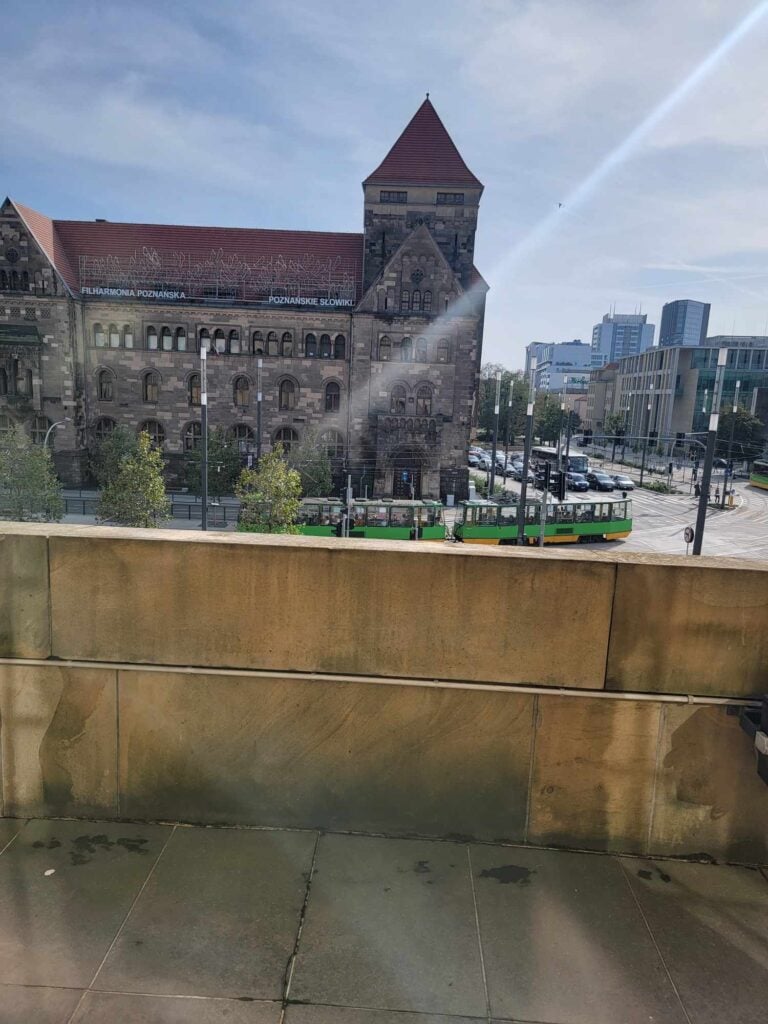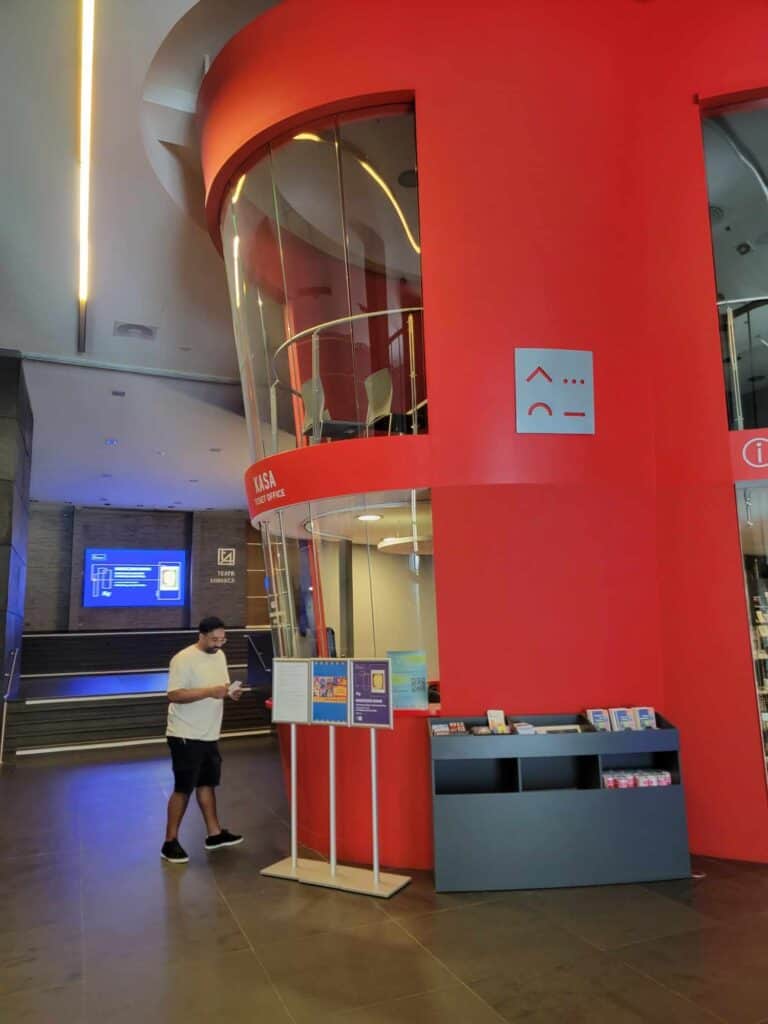The Imperial Castle in Poznan in the vibrant center of an up-and-coming city in western Poland, has a rich and amazing history. The Imperial Castle is one of the city’s most prominent landmarks and today houses the Zamek Cultural Center, but its romantic storybook facade hides a fascinating and unexpected past. I’d been to Poznan half a dozen times before I toured the Imperial Castle, and I can’t believe I waited so long!

Kaiser Wilhelm II built the castle as a symbol of German imperial might, but it was later renovated and redecorated to serve as Adolf Hitler’s headquarters in Poland during World War II. I followed in amazement as the audioguide led me through the maze of rooms perfectly preserved in their 1945 state, listening to the incredible and sobering stories of the castle’s journey to its present day. What an astounding experience.
The Imperial Castle in Poznan: History and Photos

The decision to construct the Imperial Castle in Poznań was a strategic move by the last German Emperor and King of Prussia, Kaiser Wilhelm II, who wanted to assert his control over the region. Situated in the heart of the “Grand Duchy of Poznań” (a territory annexed by Prussia in the late 1700s), the castle was designed as a conspicuous symbol of German dominance and cultural superiority. Think of it as a big ol’ finger in the eye to the Polish people.
Construction of the Imperial Castle in Poznan began in 1906, and came to completion several years later. It was designed in the neo-Renaissance style, with all the trimmings, elaborate decorative elements, a throne room, and lavish furnishings fit for the opulence of the German Empire.
World War I and the Interwar Period

The outbreak of World War I caused some damage to the castle, but the biggest change was to the political landscape. After Germany lost the war in 1918, the Kaiser abdicated his throne, and the Grand Duchy of Poznań became part of the newly independent Republic. The Imperial Castle in Poznan, designed to flaunt German might now sat squarely in sovereign Poland!
The building then served as both the residence of the Polish President, and as part of Poznan University.
World War II and the Nazi Occupation
The outbreak of World War II in 1939 and Hitler’s invasion of Poland brought about the darkest chapter in the history of the Imperial Castle in Poznan. The castle was seized by the Nazis and repurposed to serve as a military headquarters, and once again became a symbol of German power. During this time, the castle underwent extensive renovations, abolishing much of the remaining imperial design elements and reworking everything to become a Nazi administrative center, and Hitler’s headquarters in Poland. Only a few sculptural items representing agriculture and labor remained, repurposed into the new Nazi symbolism.





The castle’s structure was dominated by a soaring clock tower, originally almost 250 feet (74 meters) high. A stunning mosaic-filled chapel was installed there in 1913. Designed by August Oetken, it was modeled after the famous Palatine Chapel in Palermo, Sicily. It also held a magnificent throne room. Both the chapel and the throne room were destroyed by the Nazis, but you can still see the throne itself and a few remaining artifacts from the chapel.





Hitler’s Headquarters in the Imperial Palace in Poznan
There is no evidence that Hitler ever actually visited the castle, but he did oversee the renovations and redesign. More than 400 Polish laborers worked night and day between 1940 and 1944 gutting and renovating the entire place to become Hitler’s residence in Poznan.


Although Hitler never actually made it to his new Polish Dream Home, he planned it all out, chose the materials and oversaw the design, the renovation, and even the fixtures and furnishings. To say it was a creepy feeling walking through this place is an understatement. All of the furnishings have been destroyed or ransacked, so it is left almost completely empty, as though construction had just been completed.

This rather plain looking balcony was built at Hitler’s request. Access comes from his office and overlooks the street below where people would be able to gather to hear his speeches. The floor of the balcony was heated, allowing him to speak for long periods of time without getting cold.
Arthur Greiser, Administrator of Genocide

The overseer of the territory of Warthegau, created by Germany from parts of occupied Poland, was a ruthless, vain, cruel, and ambitious figure. Greiser (GRY-zer) played a key role in the implementation of the Nazi regime’s policies in the region and undertook a campaign to ‘Germanize’ the region in any and all ways. These policies included everything from changing street names, to the importation of huge numbers of ethnic Germans into the region, to planning and executing atrocities including genocide committed against the Polish people and its Jewish community. Under his leadership, the Imperial Castle became a center of Nazi power.




While Hitler’s private rooms and office went unused, the office of Arthur Greiser was occupied and functioning when the Red Army advanced on Poznan. Those who went to meet him were faced with a two-story staircase built with purposefully short treads and no resting place. It was built to be intimidating. This staircase led to a long hallway with many doors on the left, and frosted windows on the right so that those going to meet with Greiser would not be able to look outside as a distraction – only at the long corridor leading to his office.
As the war neared its end and the Red Army drew nearer to Poznan, Greiser saw the writing on the wall, abandoned his post, and fled to Austria. He lived there incognito for some time, thinking he had escaped justice. But one day, by random chance, a woman from Poznan recognized him. He was arrested and taken into custody by American troops and brought back to Poznan to face trial. He was found guilty of war crimes, and sentenced to death.
Greiser was hanged on the morning of June 9, 1946 on the hillside of the old Citadel in Poznan, which today is Citadel Park, in front of a crowd of 15,000.
I walked around his office thinking of the misery he had caused the Polish people, the unimaginable amount of murders committed on his order from that room, the torture and cruelty in concentration camps and gas chambers. It made me feel sick to my stomach. But despite it all, what is the thing you see from his office window today, right where his desk was? The Polish flag flying.
Soviet Rule to the Present Day
When the Imperial Castle in Poznan came under attack from the Red Army in 1944, it suffered some damages which are still visible.
You can still see bullet holes in some of the marble walls from when the Russians arrived.

After the Nazis were vanquished, a whole new authoritarian dictatorship under Stalin took its toll on Poland. And after Poland regained its independence in 1993, the palace once again became part of the university, and opened for tours to the public.


Today, after repair and restoration you can visit and explore the castle’s grand halls, view the remaining imperial decorative elements, and learn about the events that have unfolded within its walls.
It is a unique time capsule of a dark era, and one of the very rare opportunities you may have to really step back in time to the mid-1940s and walk through a Nazi administrative building, just as it looked then. And it is technically the only surviving private residence of Hitler even though he never made it there.
Tickets and Tours of the Imperial Castle in Poznan



The Imperial Castle offers guided tours that provide visitors with a comprehensive understanding of its history and architecture. The audioguide is also excellent and can be purchased at the ticket counter just inside the main entrance.
- An adult ticket is 7 PLN (about $2. or €1,60)
- The ticket with the excellent audioguide is 15 PLN (about $3.80 or €3,50)
All details about tickets, guides, and a virtual tour can be found at the Imperial Castle’s website.

All of the signage in the castle is in Polish and in English. There is also a short 10-minute film with English subtitles shown at the main staircase inside the castle once you enter.
Events and Activities
Throughout the year, the Imperial Castle hosts a variety of events, activities, and festivals, including concerts, exhibitions, and historical reenactments. These events let you experience the castle’s vibrant atmosphere and learn more about its significance in Polish history.
Gift Shop and Café


At the start or finish of your tour, you can take a few minutes at the breathtaking café on the second floor. Clean and modern, it is flooded with light and really gives you a sense of the immensity of the space which can sometimes be lost in the maze of hallways and corridors. They sell a variety of coffee, tea, and soft drinks, and lots of cakes and treats.
There is also a small gift shop right next to the ticket counter. This is the spot to pick up your audioguide.
Bonus Tip – Drinks by the Fountain


After your tour, you can visit the Stonewall Bar for a light bite to eat and a refreshment. They even have outdoor seating right next to the Lion Fountain which is one of the few larger pieces of castle art remaining from Kaiser Wilhelm’s day. You can see the bar and the lion fountain when walking around the outside of the castle, and from the castle’s balcony. I absolutely love this spot.
The castle building also houses an Irish pub called the Hades Pool, Billiard, and Karaoke Club, and on the other side the Blue Note Jazz Club. All these establishments are accessed from the outside of the castle.
The Imperial Castle in Poznan is amazing and well worth a visit and a tour. Every time I visit Poznan I learn something new, and gain more respect for the resiliency of the Polish people. My day at the castle is one I will not forget.
You can check the current weather conditions in Poznan here.
Related Posts:
- Is Poznan Worth Visiting? Poland’s Historical Capital is a Hidden Gem!
- 20 Amazing Things to Do in Poznan, Poland
- The Hilarious Must-See Goat Clock in Poznan, Poland
- The National Museum in Poznan – Discover the Hidden ‘Soul of Poland’
- Explore Citadel Park Poznan – Surprising History and Art at Every Turn
- Poznan Palm House: A Lush, Green Oasis, With Cake!
- Best Dog-Friendly Hotel in Poznan Poland: Sheraton Poznan
- 10 Unforgettable Poznan Restaurants You Have to Try
- Poznan Christmas Markets: Poland’s Best-Kept Secret!
- Is Poznan Safe? Ultimate ‘What to Know Before You Go!’
